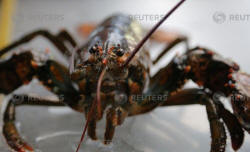U.S.-China trade war triggers seafood supply chain
shake-up
 Send a link to a friend
Send a link to a friend
 [September 28, 2018]
By Jessica DiNapoli, Allison Lampert and Caroline Hroncich [September 28, 2018]
By Jessica DiNapoli, Allison Lampert and Caroline Hroncich
NEW YORK/MONTREAL (Reuters) - The
U.S.-China trade war has triggered a seafood supply chain shake-up, with
U.S. importers scrambling to stockpile frozen Chinese squid and tilapia
ahead of looming price increases while Canada exports more lobsters to
China.
A series of retaliatory tariffs between Beijing and Washington has led
to a shift in global trade, creating winners and losers in sales of
commodities from soya to seafood to pork.
About $3 billion worth of Chinese seafood imported into the United
States is now subject to a 10 percent tariff that began this week, with
the levy rising to 25 percent on Jan. 1. In July, China imposed a 25
percent tariff on U.S. seafood, hitting lobster, a delicacy for the
Asian country's burgeoning middle class.
As a result, Chinese demand for lobster from Canada has increased, with
airports in the country's eastern provinces adding cargo flights to
accommodate higher exports.

At Halifax Stanfield International Airport, total cargo soared 42
percent in July, and 55 percent in August, compared with the same months
a year earlier, fueled by Chinese demand for seafood, said Glen Boone,
the airport's director of cargo and real estate.
Canadian shipments of live or fresh lobster to China nearly doubled to
1.25 million kilograms (2.76 million lbs) in July, their highest level
in at least six years, according to data from Statistics Canada. In
2017, Canada exported C$174.6 million ($134.06 million) worth of live or
fresh lobster to China.
Stewart Lamont, managing director of exporter Tangier Lobster in Nova
Scotia, said his Chinese sales are up 30 percent since July on an annual
basis.
"The tariff factor has really redirected business to Canada," he said.
For U.S. seafood importers, alternatives are pricier and more difficult
to source.
U.S. companies stocked up on Chinese seafood before the tariffs were
imposed. But China is the source of much of the seafood found in
low-cost frozen products sold by mass discounters such as Walmart Inc <WMT.N>,
and stockpiles could soon be running low.
U.S. importers bought 6 percent more frozen tilapia from China, the
biggest seafood import from the country, by dollar value in June and
July of 2018 compared to the same months in 2017, according to the
latest IHS Markit data available.
[to top of second column] |

A Canadian lobster is displayed outside a tank at St. Lawrence
Market South in Toronto, Ontario, Canada September 27, 2018. Picture
taken September 27, 2018. REUTERS/Chris Helgren

Imports of frozen salmon, another major Chinese import, jumped 20 percent in
dollar value.
Pacific American Fish Company Inc imported about 20 percent more scallops and
calamari in recent months to stock up before the new duties go into place, said
Chief Executive Peter Huh. The seafood importer and distributor may add to
stockpiles to bypass the looming additional 15 percent tariff coming next year,
he said.
"That's the only option we have," said Huh, explaining why he hoarded
higher-value products to maximize his savings.
Four other seafood importers said they were also bulking up their purchases
ahead of time. Jim Heston of the Great Fish Company said the Winter Haven,
Florida, importer added to its inventory to meet demand from customers who hoped
to buy early fearing the new costs.
The tariff dispute has also delivered some supply-chain surprises, with
increasing Canadian demand for lobster from the state of Maine, the biggest U.S.
harvester of the crustaceans, according to industry groups, wholesalers and
exporters on both sides of the border.
Stephanie Nadeau, owner of The Lobster Co, a Maine wholesale distributor, has
seen a 40 percent drop in her overall sales in September as Chinese buyers look
to Canada to satisfy its demand for the crustacean.
Yet prices remain stable in Maine for lobster harvesters, she said, because of
demand from north of the border.
"The Canadians have stepped in," Nadeau said.
(Reporting by Jessica DiNapoli and Caroline Hroncich in New York and Allison
Lammpert in Montreal; Additional reporting by Tom Polansek in Chicago and
Allison Martell in Toronto; Editing by Tom Brown)
[© 2018 Thomson Reuters. All rights
reserved.] Copyright 2018 Reuters. All rights reserved. This material may not be published,
broadcast, rewritten or redistributed.
Thompson Reuters is solely responsible for this content.
 |